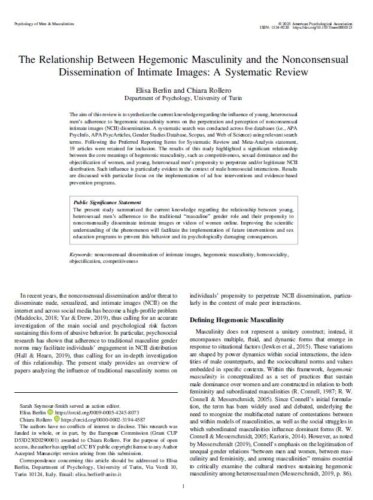Shaping Sexual Behaviors & Sexual Scripts
The relationship between hegemonic masculinity and the nonconsensual dissemination of intimate images: A systematic review.
Open Access: No.
Abstract
The aim of this review is to synthetize the current knowledge regarding the influence of young, heterosexual men’s adherence to hegemonic masculinity norms on the perpetration and perception of nonconsensual intimate images (NCII) dissemination. A systematic search was conducted across five databases (i.e., APA PsycInfo, APA PsycArticles, Gender Studies Database, Scopus, and Web of Science) using relevant search terms. Following the Preferred Reporting Items for Systematic Review and Meta-Analysis statement, 19 articles were retained for inclusion. The results of this study highlighted a significant relationship between the core meanings of hegemonic masculinity, such as competitiveness, sexual dominance and the objectification of women, and young, heterosexual men’s propensity to perpetrate and/or legitimate NCII distribution. Such influence is particularly evident in the context of male homosocial interactions. Results are discussed with particular focus on the implementation of ad hoc interventions and evidence-based prevention programs.
Relevance
“A significant association was found between individuals’ attitudes toward the distribution of NCII [nonconsensual intimae images) and men’s objectification of women, the display of competitive attitudes toward peers, attempts to continually reaffirm men’s sexual dominance over women, and the exploitation of heterosexual sex as a direct medium of male homosocial bonding…most of these values can also be identified in relation to other forms of sexual abuse,” including using deception to obtain sex, sexual aggression, and group sexual assault or ‘gang rape.’ This highlights “the continuity between the various forms of violence against women that can be perpetrated in the online and the offline environments.”
Men typically share nonconsensual nude and sexually explicit images as a form of “currency,” or “digital evidence” of one’s sexual exploits, intended to elevate status among male peers (increase “masculine social capital”) or to provide “the group with new opportunities to collectively judge women’s bodies and sexual behavior.”
“The present review highlighted that the digital environment is often perceived as a safe space where individuals can freely denigrate the women portrayed in the contents being disseminated.”
In online platforms that host nonconsensual intimate images, moreover, the female victims “of the disseminated content are generally displayed similarly to how women are presented on mainstream pornography websites” which are “typically characterized by sexually dominant men and passive and/or sexually submitted women.” This images, platforms, and pornography in general also “reflect the prevalence of male voyeurism among the mainstream media industry.”
Last, the women depicted in these nonconsensual images are typically “stigmatized and condemned” while the young men who disseminate these images are “generally praised.”
Citation
Berlin, E., & Rollero, C. (2025). The relationship between hegemonic masculinity and the nonconsensual dissemination of intimate images: A systematic review. Psychology of Men & Masculinities. https://dx.doi.org/10.1037/men0000523

